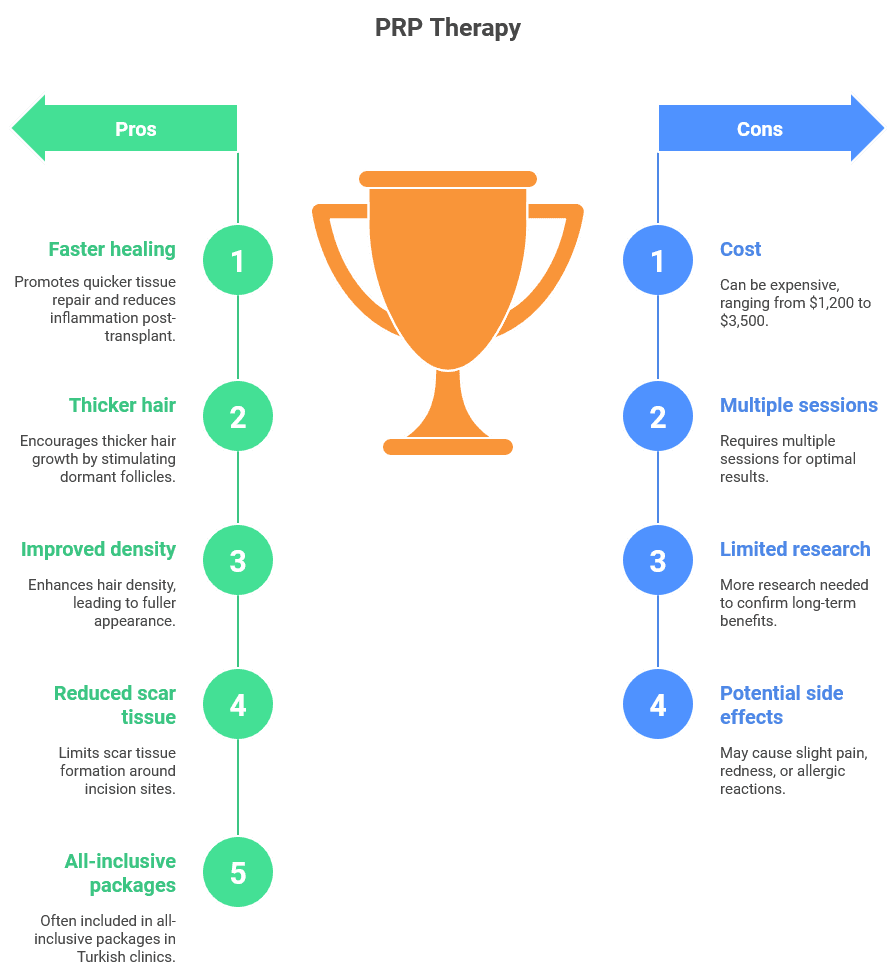Getting a hair transplant procedure is the best way to restore a full head of hair after years of hair loss, as the success rates are within 95–98% and the final results look very natural. However, this approach will only help deal with the side effects of male or female pattern baldness and does not reverse the underlying genetic or other causes.
That’s why the top doctors in the field often recommend additional interventions that complement the surgery, PRP therapy being the most common one. We will go into more detail about how it works, the costs involved, and the results it can provide, to help you decide whether it is truly worth it.
What is Platelet Rich Plasma (PRP) Therapy?
The goal of PRP is to use concentrated platelets from the patient’s blood to promote healing in the recipient area of the scalp after an operation. This process involves three distinct steps:
- Drawing and preparing the blood – a small amount of blood is taken from the patient’s arm, and the collection tube is then placed in a centrifuge machine.
- Separating the platelets – the centrifuge machine spins the tube at high speeds for 10 minutes, which separates it into red blood cells, platelets, and plasma.
- The PRP solution is injected into the scalp – the doctor will draw the solution into a syringe and then inject it into the areas of the head where the grafts were transplanted.
The entire process only takes about 30 minutes, and follow-up sessions are advised.
Why Consider PRP After a Hair Transplant?
After a FUE hair transplant, the donor follicles will begin the healing process, and this is when the PRP hair treatment helps add important growth factors to the area. These increase the blood supply to the roots, promoting faster healing and causing the strands to grow back thicker.
It can also help stimulate dormant hair follicles in the months after the surgery, reducing the time they spend in the resting phase, which leads to quicker hair regrowth.
When Should You Get PRP After Hair Transplant Surgery?
High-end Turkish clinics like Asli Tarcan have a set hair transplant PRP treatment plan, which involves two sessions – one right after the operation and one the next day.
However, some doctors suggest waiting for the scalp to fully heal, usually after the second week post-surgery, while there are some indications that it can be as short as one week after and up to a couple of months. There is no conclusive answer, but recent studies indicate that it might be beneficial to start fairly early to aid with the recovery process.
Benefits of PRP After a Hair Transplant
The biggest immediate benefit is that PRP can reduce inflammation during the first few days post hair transplant and help the tissue repair itself quicker. By promoting improved blood flow to each hair follicle and providing growth factors, it can also increase graft survival rates and decrease the length of the dormant phase, leading to more impressive and thicker natural hair growth much sooner.
It can even improve density and overall length, as well as limit the occurrence of scar tissue around the incisions.

How Many PRP Sessions Are Needed?
Some doctors believe that the initial session or two should be enough for optimal hair restoration, but others prefer several sessions per month for several months. This opinion is based on a recent small-scale study where regular sessions started one week after the operation, and the 15 patients received three sessions each month for the next three months.
They reportedly had more impressive hair transplant before and after results than expected, better density and thickness; however, more research is needed for more conclusive results. It’s also worth mentioning that the study didn’t feature a control group and used averages based on previous patients as the baseline.
Risks and Side Effects of PRP After Hair Transplant
The good news is that this type of therapy is both minimally invasive and incredibly low risk, while promising improved hair transplant results, making it quite safe. The biggest risks during the early stages of recovery are related to infections or allergic reactions, which are fairly unlikely to be caused by PRP, as it has antimicrobial effects.
The most common side effects you might encounter are slight pain and redness at the injection site, light headaches, and an allergic rash forming on the scalp. Other than that, most patients will be just fine.
Cost of PRP After a Hair Transplant
In the US and Europe, a single PRP injection can cost around $400 to $600, which means you may need anywhere from $1,200 to $3,500 for the full treatment, which involves several sessions that may take one to three injections each.
However, in Turkey, these are usually a standard part of the all-inclusive package, which also includes a stay at a 5-star hotel and VIP transfer. You usually get two full sessions along with the procedure and all the travel arrangements, although even if you get it separately, it is only around $125 to $150 per session in Turkish clinics.
Is PRP Worth It After a Hair Transplant?
Most people considering a hair transplant in Istanbul immediately start looking into all the additional treatments and can get a bit confused about the prices or the effectiveness of each. Drugs like Minoxidil and Finasteride can help reduce further balding and strengthen existing hairs, but PRP actually helps the transplanted hair follicles heal up faster and grow thicker and longer.
It also helps you spend less time in the awkward phase from the end of month one to the beginning of month six, where the new hair falls out and the strands start growing back at different stages, causing a patchy look.
When you consider all these benefits and the fact that all the top Turkish clinics offer PRP as part of their all-inclusive packages, there really is no reason to avoid this incredibly useful treatment.

